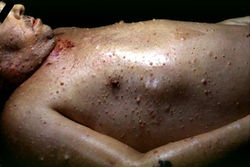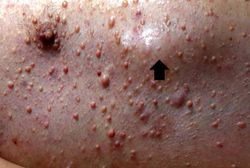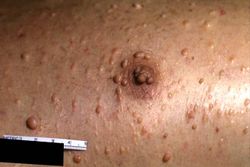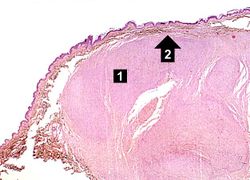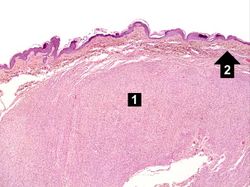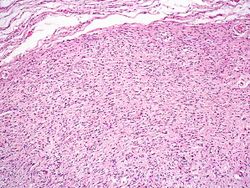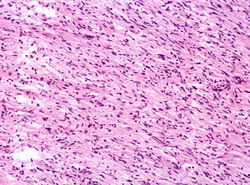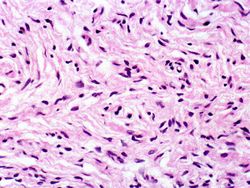Difference between revisions of "IPLab:Lab 5:Neurofibromatosis"
Seung Park (talk | contribs) |
Seung Park (talk | contribs) |
||
| Line 22: | Line 22: | ||
* <spoiler text="What are the classic clinical features of neurofibromatosis type 1?">Although protean in its clinical expression, patients with neurofibromatosis usually have multiple neural tumors all over the body, numerous pigmented skin lesions (”café au lait“ spots), and pigmented iris hamartomas (also called Lisch nodules). Other common clinical manifestations include skeletal lesions (scoliosis, bone cysts, thinning of the cortex of long bones) and mild intellectual impairment.</spoiler> | * <spoiler text="What are the classic clinical features of neurofibromatosis type 1?">Although protean in its clinical expression, patients with neurofibromatosis usually have multiple neural tumors all over the body, numerous pigmented skin lesions (”café au lait“ spots), and pigmented iris hamartomas (also called Lisch nodules). Other common clinical manifestations include skeletal lesions (scoliosis, bone cysts, thinning of the cortex of long bones) and mild intellectual impairment.</spoiler> | ||
* <spoiler text="What is the etiology of the coagulopathy seen in this patient?">Liver failure.</spoiler> | * <spoiler text="What is the etiology of the coagulopathy seen in this patient?">Liver failure.</spoiler> | ||
| + | |||
| + | == Additional Resources == | ||
| + | === Reference === | ||
| + | * [http://emedicine.medscape.com/article/1177266-overview eMedicine Medical Library: Type 1 Neurofibromatosis] | ||
| + | * [http://emedicine.medscape.com/article/1112001-overview eMedicine Medical Library: Dermatologic Manifestations of Neurofibromatosis Type 1] | ||
| + | * [http://www.merckmanuals.com/professional/pediatrics/neurocutaneous_syndromes/neurofibromatosis.html Merck Manual: Neurofibromatosis] | ||
| + | * [http://www.nlm.nih.gov/medlineplus/neurofibromatosis.html Neurofibromatosis: MedlinePlus] | ||
| + | |||
| + | === Journal Articles === | ||
| + | * Kiliç S, Tezcan I, Sanal O, Ersoy F. [http://www.ncbi.nlm.nih.gov/pubmed/11737751 Common variable immunodeficiency in a patient with neurofibromatosis]. ''Pediatr Int'' 2001 Dec;43(6):691-3. | ||
| + | |||
| + | === Images === | ||
| + | * [http://peir.path.uab.edu/library PEIR Digital Library] | ||
| + | ** Try the following searches: | ||
| + | *** neurofibromatosis | ||
| + | *** von recklinghausen's disease | ||
| + | * [http://library.med.utah.edu/WebPath/CNSHTML/CNSIDX.html#11 WebPath: CNS Neoplasms] | ||
{{IPLab 5}} | {{IPLab 5}} | ||
[[Category: IPLab:Lab 5]] | [[Category: IPLab:Lab 5]] | ||
Revision as of 04:38, 22 August 2013
Contents
Clinical Summary[edit]
This 45-year-old divorced white male came to the emergency room with severe hepatic cirrhosis and aspiration pneumonia. Shortly after admission he developed cardiac arrhythmias and died. Significant past history included alcohol abuse, cirrhosis, and neurofibromatosis. He had no family history of neurofibromatosis, but his condition was diagnosed at age 17 when he developed neurofibromas along the lateral chest wall. There was no history of continued follow-up after this initial diagnosis.
Autopsy Findings[edit]
The patient was covered with variably sized subcutaneous nodules ranging from 0.5 to 2.5 cm in diameter. Other significant findings included micronodular hepatic cirrhosis (liver weight: 1760 grams), ascites (500 ml), and splenomegaly (weight: 260 grams).
Images[edit]
Study Questions[edit]
Additional Resources[edit]
Reference[edit]
- eMedicine Medical Library: Type 1 Neurofibromatosis
- eMedicine Medical Library: Dermatologic Manifestations of Neurofibromatosis Type 1
- Merck Manual: Neurofibromatosis
- Neurofibromatosis: MedlinePlus
Journal Articles[edit]
- Kiliç S, Tezcan I, Sanal O, Ersoy F. Common variable immunodeficiency in a patient with neurofibromatosis. Pediatr Int 2001 Dec;43(6):691-3.
Images[edit]
- PEIR Digital Library
- Try the following searches:
- neurofibromatosis
- von recklinghausen's disease
- Try the following searches:
- WebPath: CNS Neoplasms
| |||||
Cirrhosis is a liver disease characterized by necrosis, fibrosis, loss of normal liver architecture, and hyperplastic nodules.
In alcoholics, aspiration pneumonia is common--bacteria enter the lung via aspiration of gastric contents.
Arrhythmias are abnormal heart rhythms.
A normal liver weighs 1650 grams (range: 1500 to 1800 grams).
Ascities is the accumulation of fluid with in the abdominal cavity. There should be less than 30 ml of fluid in the peritoneal cavity.
260 grams)
Splenomegaly means enlargement of the spleen. The normal spleen weighs 155 grams.
